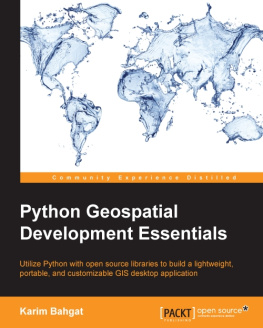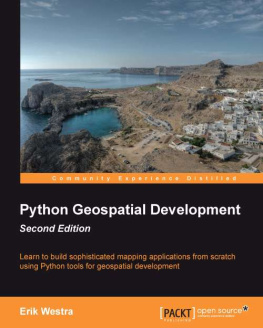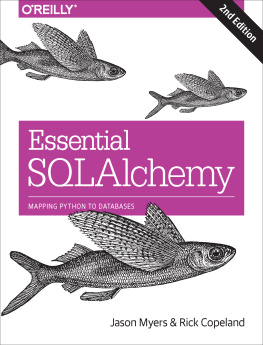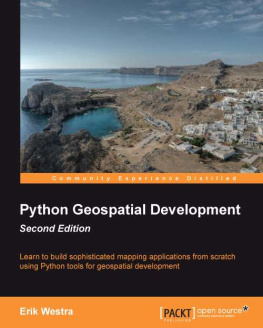About the Author
Karim Bahgat holds an MA in peace and conflict transformation from the University of Troms in Norway, where he focused on the use of geographic information systems (GIS), opinion survey data, and open source programming tools in conflict studies. Since then, he has been employed as a research assistant for technical and geospatial work at the Peace Research Institute Oslo (PRIO) and the International Law and Policy Institute (ILPI). Karim was part of the early prototyping of the PRIO-GRID unified spatial data structure for social science and conflict research, and is currently helping develop a new updated version (https://www.prio.org/Data/PRIO-GRID/).
His main use of technology, as a developer, has been with Python programming, geospatial tools and mapping, the geocoding of textual data, data visualization, application development, and some web technology. Karim is the author of a journal article publication, numerous data- and GIS-oriented Python programming libraries, the Easy Georeferencer free geocoding software, and several related technical websites, including www.pythongisresources.wordpress.com.
I am very grateful for the detailed feedback, suggestions, and troubleshooting of chapters from the reviewers; the encouragement and guidance from the publisher's administrators and staff, and the patience and encouragement from friends, family, colleagues, and loved ones (especially my inspirational sidekicks, Laura and Murdock). I also want to thank all my teachers at the Chapman University and University of North Dakota, who got me here in the first place. They helped me think out of the box and led me into this wonderful world of geospatial technology.
About the Reviewers
Gregory Giuliani is a geologist with a PhD in environmental sciences (theme: spatial data infrastructure for the environment). He is a senior scientific associate at the University of Geneva (Switzerland) and the focal point for spatial data infrastructure (SDI) at GRID-Geneva. He is the manager of the EU/FP7 EOPOWER project and the work package leader in the EU/FP7 enviroGRIDS and AfroMaison projects, where he coordinates SDI development and implementation. He also participated in the EU/FP7 ACQWA project and is the GRID-Geneva lead developer of the PREVIEW Global Risk Data Platform (http://preview.grid.unep.ch). He coordinates and develops capacity building material on SDI for enviroGRIDS and actively participates and contributes to various activities of the Global Earth Observation System of Systems (GEOSS). Specialized in OGC standards, interoperability, and brokering technology for environmental data and services, he is the coordinator of the Task ID-02 "Developing Institutional and Individual Capacity" for GEO/GEOSS.
Jorge Samuel Mendes de Jesus has 15 years of programming experience in the field of Geoinformatics, with a focus on Python programming, OGC web services, and spatial databases.
He has a PhD in geography and sustainable development from Ben-Gurion University of the Negev, Israel. He has been employed by the Joint Research Center (JRC), Italy, where he worked on projects such as EuroGEOSS, Intamap, and Digital Observatory for Protected Areas (DOPA). He continued his professional career at Plymouth Marine Laboratory, UK, as a member of the Remote Sensing Group contributing to the NETMAR project and actively promoting the implementation of the WSDL standard in PyWPS. He currently works at ISRICWorld Soil Information in the Netherlands, where he supports the development of Global Soil Information Facilities (GSIF).
Athanasios Tom Kralidis is a senior systems scientist for the Meteorological Service of Canada, where he provides geospatial technical and architectural leadership in support of MSC's data. Tom's professional background includes key involvement in the development and integration of geospatial standards, systems, and services for the Canadian Geospatial Data Infrastructure (CGDI) with Natural Resources Canada. He also uses these principles in architecting RsEau, Canada's water information portal. Tom is the lead architect of the renewal of the World Ozone and Ultraviolet Radiation Data Centre (WOUDC) in support of the WMO Global Atmospheric Watch.
Tom is active in the Open Geospatial Consortium (OGC) community, and was lead contributor to the OGC Web Map Context Documents Specification. He was also a member of the CGDI Architecture Advisory Board, as well as part of the Canadian Advisory Committee to ISO Technical Committee 211 Geographic information/Geomatics.
Tom is a developer on the MapServer, GeoNode, QGIS, and OWSLib open source software projects, and part of the MapServer Project Steering Committee. He is the founder and lead developer of pycsw, an OGC-compliant CSW reference implementation. Tom is a charter member of the Open Source Geospatial Foundation. He holds a bachelor's degree in geography from York University, a GIS certification from Algonquin College, and a master's degree in geography and environmental studies (research and dissertation in geospatial web services/infrastructure) from Carleton University. Tom is a certified Geomatics Specialist (GIS/LIS) with the Canadian Institute of Geomatics.
John Maurer is a programmer and data manager at the Pacific Islands Ocean Observing System (PacIOOS) in Honolulu, Hawaii. He creates and configures web interfaces and data services to provide access, visualization, and mapping of oceanographic data from a variety of sources, including satellite remote sensing, forecast models, GIS layers, and in situ observations (buoys, sensors, shark tracking, and so on) throughout the insular Pacific. He obtained a graduate certificate in remote sensing, as well as a master's degree in geography from the University of Colorado at Boulder, where he developed software to analyze ground-penetrating radar (GPR) for snow accumulation measurements on the Greenland ice sheet. While in Boulder, he worked with the National Snow and Ice Data Center (NSIDC) for 8 years, sparking his initial interest in earth science and all things geospatial; an unexpected but comfortable detour from his undergraduate degree in music, science, and technology at Stanford University.










